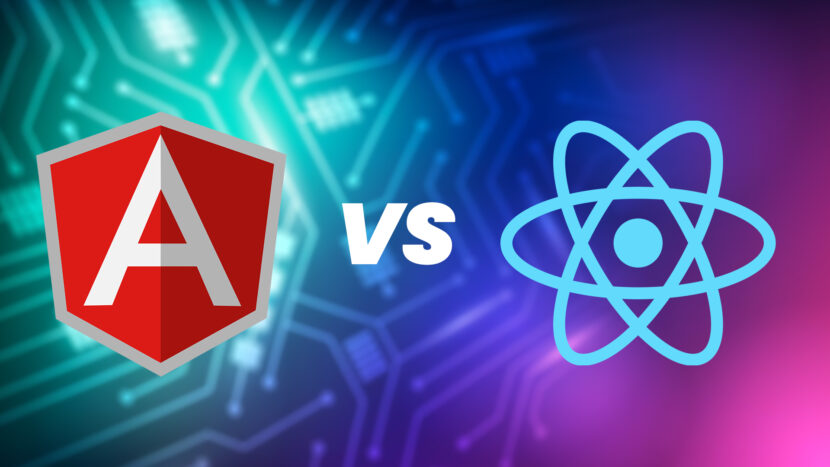- Angular and React are two open-source JavaScript frameworks used to create dynamic web apps.
- Angular has a higher learning curve, with features such as decorators and modules.
Dynamic web apps are made using the open-source JavaScript framework, Angular. Angular is a component-oriented architecture. Google developed Angular in 2016, which improves HTML syntax and enables us to express our application components briefly and clearly using HTML templates. Two developers, Adam Abrons and Misko Hevery, created Angular as a side project.
They created the Get Angular initiative to streamline website creation and enable front-end and back-end interaction for web designers. Since HTML employs angular brackets, Adam Abrons, a Google developer, and Misko Hevery worked together on the angular project.
A Detailed Guide to Angular and React
A front-end framework called Angular is used to create declarative, two-way data-binding web apps. It has a strong community and ecology, offers a wide range of features, and is a very efficient tool.
The application framework Angular is made up of several components and is very opinionated. It comes with a lot of features out of the box, like routing and modules.
In addition to making websites, React.Js may also be used to make desktop, mobile, and virtual reality applications. To construct interactive elements for website UIs (User Interfaces), the React JavaScript library is used in website development. It allows you to create complex user interfaces from discrete, tiny “components” of code.
The view library emphasizes composition and is very modular. You can write a different piece of code and combine it with the existing parts of your application to add functionality or features. As a result, adding new features is made simple because there is no requirement to follow a specific structure or alter the existing code.
Which One is Better: Angular or React?
Architecture:
- Angular: Model-View-Controller (MVC) architecture is the basis for the Model-View-Controller (Angular) framework. Segmenting the code into modules, components, services, and directives, offers an organized method for creating web applications. With the help of Angular’s powerful component system, you can efficiently manage the behavior and state of reusable UI components.
- React: React is a JavaScript library that is exclusive to the View layer. It employs a component-based design that enables the creation of reusable user interface (UI) components using JavaScript and JSX (a JavaScript syntax extension). React components are in charge of handling their state and rendering a portion of the user experience.
Learning Curve:
- Angular: Compared to React, Angular has a higher learning curve. Decorators, modules, dependency injection, and TypeScript (a statically-typed superset of JavaScript) are just a few of the ideas and technologies that Angular introduces. Particularly for developers who are unfamiliar with these notions or have a background in JavaScript, these concepts may take more time and effort to comprehend and master.
- React: React features a less complicated API and a simpler learning curve. Its fundamental ideas, such as component-based development, and the virtual DOM, are not too difficult to understand. For those who are already familiar with JavaScript and HTML, learning React can go more smoothly.
Ecosystem and Community:
- Angular: It is supported by Google and has a large community. It is more established and has a more developed ecosystem with a larger selection of tools, libraries, and resources. With tools like NgRx, Angular offers an integrated development environment right out of the box, complete with capabilities like a strong router, form validation, and state management. Angular’s official documentation is comprehensive and up-to-date.
- React: React has a sizable and vibrant community and has experienced tremendous growth. It features a huge ecosystem with a ton of community-created content, third-party libraries, and tools. Due to React’s ubiquity, there is a plethora of tutorials, articles, and other online resources available to assist developers in their learning and problem-solving.
Performance:
- Angular: To enhance performance, Angular makes use of a built-in change detection system. It tracks modifications to the application’s state using a hierarchical tree structure and updates the user interface only where necessary. Performance gains and efficient rendering are possible outcomes of this strategy.
- React: React uses a diffing mechanism and a virtual DOM to update the UI quickly. React creates a virtual representation of the user interface (UI), compares it to the previous state, and makes the appropriate adjustments to the actual DOM when the application state changes. This method performs better than conventional DOM manipulation since it minimizes direct manipulation of the real DOM.
Conclusion
Both Angular and React JS are well-liked, but the application determines which is superior. Each has a certain use, as we have mentioned. Using Angular is both possible and suggested if your application is enterprise-grade. React JS helps create front-end user interfaces and an effective UI. It is, therefore, impossible to state with certainty which of the two is better. Everything depends on the situation in which you use them. In addition to the fundamental characteristics and features of each framework, choosing between Angular and ReactJS depends on skills and personal preferences.





